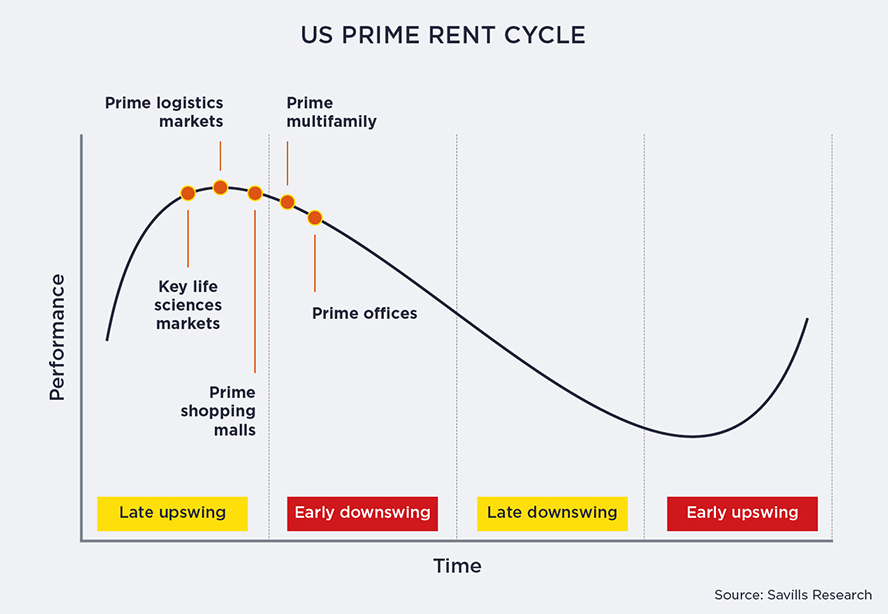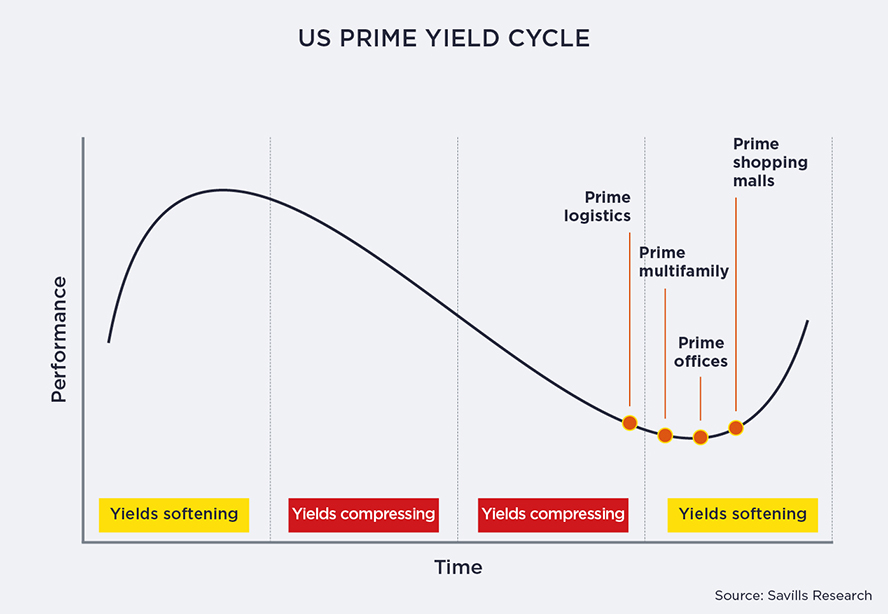Key themes
The coming year looks set to bring more opportunities for investors than 2022 – once the Federal Reserve is satisfied inflation is under control and halts rate increases. In addition, after a slow second half of 2022 for the commercial real estate market, market participants have ample dry powder to deploy.
With many owners caught out by the higher cost of capital and operating under negative leverage, opportunistic investors and lenders are in a strong position to take advantage. Economic forecasts for the US economy are more optimistic than those for Europe and Asia, so we can expect foreign investors to become more active in the region.
Prime rent and yield cycles
Prime multifamily and logistics lead in 2023
Investor appetite will remain most prominent for prime multifamily and logistics properties. Prime multifamily should hold up better in the Northeast and the Southeast than on the West Coast, where it is most susceptible to the ongoing correction in the technology sector.
As for prime logistics, expect properties in the key gateway markets of Southern California, New Jersey and South Florida to continue to outperform, due to prevailing extreme supply-demand imbalances.
The office sector enters 2023 facing arguably more questions than any other property sector. With the ongoing stickiness of work from home – and many industry surveys indicating that employees prefer the hybrid workplace – projections for office space demand over the short term are increasingly problematic.
This is compounded by the ongoing trend for office space densification on the part of corporate occupiers, coupled with a major correction in the technology sector. Expect office investment sales activity in 2023 to ease off as market participants stall for indications of what the office sector will eventually look like.
Value-add and opportunistic strategies face headwinds
Value-add strategies, including the repositioning of office properties to life sciences, healthcare facilities and hotels, will continue to be at the forefront in 2023. However, high construction and renovation costs will remain a major headwind as investors seek out yield.
Opportunistic strategies, involving the repurposing of distressed office and retail assets, will face the same problem. As a result, expect more interest in alternative niche property sectors, such as data centres, senior housing and student housing, in 2023.
Although North America is behind Europe on carbon emissions regulations in the commercial real estate market, institutional investors with ESG mandates will become increasingly vocal in 2023 as to how their general partners identify, acquire and operate their assets. As a result, expect a higher focus on “greening” real estate portfolios this year and beyond.
Savills top tips: US sectors to watch in 2023
- Prime multifamily (north-east and south-east)
- Prime logistics (Southern California, New Jersey, South Florida)
- Cold storage industrial
- Healthcare facilities (on-campus)
- Life sciences repositioning (Boston, San Francisco, San Diego)
- Healthcare facilities repositioning (off-campus)
- Hotel repositioning
- Repurposing of distressed offices and retail
- Data centres
- Senior housing
- Student housing
- Shopping malls
- Neighbourhood retail centres





